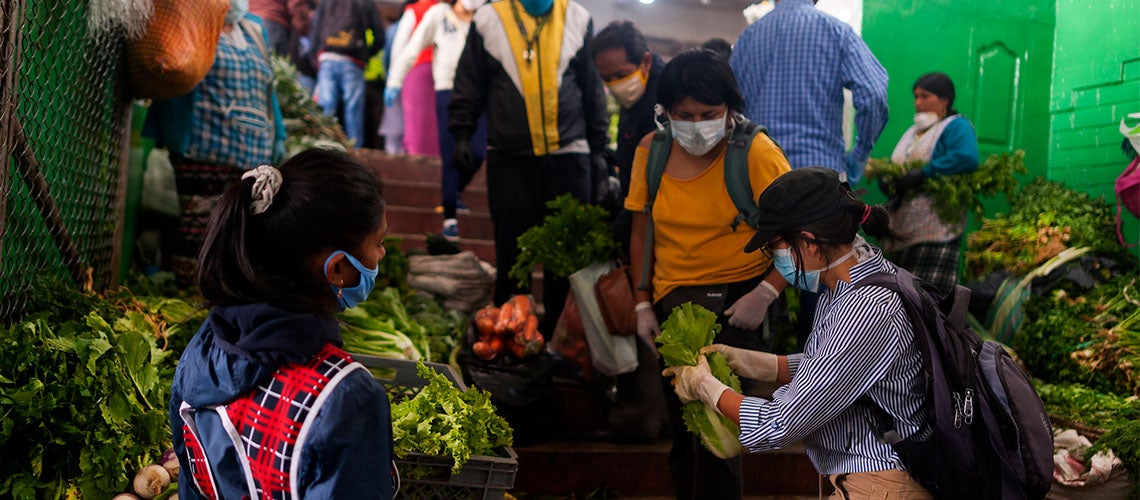 People buying food in San Roque Market, Quito, Ecuador
People buying food in San Roque Market, Quito, Ecuador
The region has lived through a dramatic period of setbacks since March 2020, when it started to feel the effects of the pandemic. It hit LAC harder than any other region in the world, both in terms of per capita deaths and economic contraction. Poverty also rose because of the health crisis.
The region managed to recover significantly through 2021, thanks to aggressive vaccine rollouts and the expansion of programs to mitigate impacts on the most affected populations. However, rapidly increasing food and fuel prices could deal yet another significant setback to the region’s citizens.
While the Russian invasion of Ukraine has stoked the inflation fire, most countries have been experiencing symptoms of rising prices since last year. Fuel, as measured by world oil prices, and international food prices were rising throughout 2021, as Figure 1 shows.
In fact, by the end of 2021 median consumer price inflation in the region had nearly doubled, jumping to 7% from an average of 4% between 2015 and 2019. Inflation has affected countries differently, of course, but all are seeing increases, with the highest rates in Argentina, Brazil, Chile, Uruguay, and Venezuela.
In LAC, food and energy were the main contributors to inflation in 2021 . They accounted for more than 90% of inflation in Costa Rica, 75% in Paraguay, 66% in Brazil, and almost 60% in Colombia. Empirical analysis confirms that inflation in the region was highly correlated with demand side pressures stemming from expansionary policies, as well as supply chain pressures, energy prices, and currency depreciation.
Inflation is currently projected to increase further in 2022, due mainly to rising commodity prices and global supply disruptions. Suriname and Haiti, for example, are expected to experience double-digit inflation. Food-importing countries will be more quickly affected by further increases in international food prices.
Why worry about the impact of inflation in the region?
One major reason is that inflation puts significant pressure on households’ disposable incomes. In LAC, the budget share of food and energy prices in the consumption basket is about 40%, with the highest levels in Peru, Mexico, Brazil, and Paraguay, as shown in Figure 2.
Especially concerning are negative impacts on the poorest and most vulnerable households in urban areas, which spend a large proportion of their total income on food and other basic commodities. They are suffering the harshest effects of rising prices. (For a global view of the impact of inflation and commodity price increases on poverty, as well as a take on the broader economic juncture, take a look at World Bank President David Malpass’ recent speech at the Warsaw School of Economics).
Inflation in other goods and services, such as those related to gas prices, also hit consumers everywhere. Such price hikes also contribute to large welfare losses through higher transport costs. Even worse, people in Latin America and the Caribbean are seeing food and fuel prices skyrocket while wages on average remain below pre-pandemic levels.
Rising poverty, food insecurity
In a region where poverty alleviation was abruptly reversed during the pandemic, a major concern is that the recovery that started in 2021 does not help families rise above the poverty line.
Poverty, defined as living on less than $5.5 a day, increased from 24% to 26.5% between 2019 and 2021 but had started to decline slowly in 2022. Now, preliminary analysis indicates that poverty levels are expected to remain at 26% in 2022 rather than return to pre-pandemic levels. By this calculation, nearly 13 million LAC citizens will lose the opportunity to see significant improvement in their welfare.
In addition, there could be many more families at risk of food insecurity and falling into poverty in 2022 due to higher inflation and food prices.
Food insecurity during the pandemic was most salient in Caribbean Island nations such as St. Lucia, Jamaica, Haiti, and Dominica. Unfortunately, this is likely to be the case again at the present time because Caribbean countries depend heavily on food -and non-food- imports. It could also disproportionately affect the urban poor across the region, as well as many of the recent migrant populations – including those coming from Venezuela- who are still struggling to make ends meet in their new homes. Rising food insecurity is likely to worsen the poverty and economic vulnerability of many in LAC.
A final but important concern is inequality. Inflation tends to hit the poor hardest, while better off families have more instruments at their disposal to avoid the worst impacts. That’s why inflation is likely to aggravate inequality. By some measures LAC is already the most unequal region in the world. Unfortunately, the rising prices we observe today might accentuate this situation, adding fuel to ongoing social tensions.
Many countries are responding to the inflation surge by trying to influence prices directly – limiting food exports or keeping fuel prices at lower levels than in global markets. This approach can help quell tensions domestically, but it has a negative impact on global welfare.
Historical experience demonstrates that trade restrictions tend to exacerbate global food crises. They might keep prices lower within a country for the short term, while pushing prices higher in global markets, worsening the situation for others. Keeping gasoline or diesel prices low may help curb social demands but it’s a costly approach that often mostly benefits groups that are less needy. Additionally, keeping fossil fuels cheaper impacts the climate negatively and detracts from LAC’s long-term objective of a green growth transformation.
What to do?
To cushion the impacts of inflation on the poor, governments should ramp up support through well targeted social protection programs . Such programs have been a critical component of the COVID-19 response and protected millions of Latin Americans from the worst impacts of the crisis.
Using these types of programs to alleviate the suffering from higher food and fuel prices is more effective than the alternatives. However, efforts to prioritize the protection of the poor and most vulnerable should be consistent with sound fiscal management, given higher public debt levels in the region after the pandemic.
Frankly, we don’t know when the current inflation surge will end. We don’t know how long the war in Ukraine will last or how quickly we can expect alternative supplies of grains, fuels and fertilizers to come on stream.
What we do know is that central banks across the region have been raising interest rates to dampen demand, which will negatively impact already low growth rates (LAC is now projected to grow at only 2.2% this year, one of the lowest rates in the world).
In light of the uncertainties, it is important to follow a flexible approach that protects the poor while reducing overall stress on fiscal resources. And it might be a good time to introduce growth-friendly reforms to boost investment and create the jobs urgently needed to make our region a more equal and prosperous place for all.





Join the Conversation